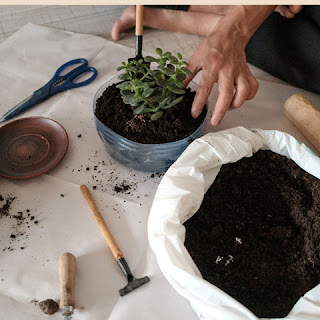Planting isn't just about what you plant; where you plant matters too. Whether you're growing indoor houseplants or an outdoor garden, choosing the appropriate container can drastically alter the health and vigor of your plants. We'll go through all the important things to think about while selecting the ideal pot in this tutorial.
 |
Choosing the Ideal Pot |
Size Counts
One of the most important aspects of container gardening is pot size. The health of your plants depends on the size of container you choose. Here are some crucial things to remember:
Room to Grow:
Select a pot that will allow the roots of your plant to spread out freely. Your plant may become root-bound in a pot that is too small, which could impede its growth.
Measurements:
Make sure the pot's size corresponds with the plant's size. A giant plant in a small container can easily become root-bound, whereas a tiny plant in a massive pot may appear lost.
Think About Plant Type:
Different plants demand different amounts of area. Choose a pot size based on your plant's individual requirements after researching them.
Drainage Is Essential
Your plants' wellbeing depends on proper drainage. Insufficient drainage in a pot can result in soggy soil and decaying roots. Here are some things to remember:
It is always advisable to select pots that have holes for drainage. This keeps the soil from becoming soggy by letting extra water escape. Use a beautiful pot that lacks drainage as a cachepot, which is an outside container that has a drainage pot inside.
Elevate the Pot:
To raise your pot a little bit off the ground if it lacks drainage holes, think about using pot feet or tiny wooden blocks. This will facilitate better drainage and airflow.
Type of Soil:
Choose potting mix that drains effectively and meets the demands of your plant. For example, cacti and succulents need a mix made especially for them.
Substance Matters
Your choice of pot material will affect not only its appearance but also its ability to retain moisture and regulate temperature. Typical pot ingredients consist of:
Earth Cotta:
These pore-filled Although they aerate well, clay pots can dry out quickly. For plants that prefer drier soil, they work great.
Plastic:
Plastic pots are affordable, lightweight, and have good moisture retention. They could, nevertheless, also be vulnerable to warming in the sun.
Ceramic:
Pots made of ceramic are available in a variety of hues and designs, giving your landscape a beautiful touch. They are good for a variety of plants and hold moisture well.
Wood:
Roots are protected from harsh temperatures and look good in wooden pots. But over time, they might disintegrate, so think about lining them with plastic.
Metal:
While metal pots are fashionable, they can get very hot in the sun. Use them with warm-weather-tolerant plants.
Think About Location
Your choice of containers can influence where you set your potted plants. Here are some ways that location may affect your choice:
Inside or outside:
Decide whether you want your plant to live outside or inside. While indoor pots can be more aesthetically pleasing, outdoor pots must endure the elements.
Sunlight:
Take into account how much sunlight the area gets. In warmer weather, lighter-colored pots can reflect sunlight and help keep roots cool.
Aesthetic Match:
Whether it's a sunny space in the garden or a nook in your living room, the pot's style and color should go well with the surroundings.
Make a Future Maintenance Plan
Lastly, think about how simple it will be to care for your houseplant. It could be necessary for you to:
Make a Future Maintenance Plan
Lastly, think about how simple it will be to care for your houseplant. It could be necessary for you to:
Moving the Pot:
If necessary, make sure the pot isn't too heavy to transfer. For large and heavy pots, use casters.
Repotting:
Select a pot that facilitates easy repotting if you anticipate needing to do so on a regular basis.
Access to Drainage:
Make sure you can get to the drainage hole with ease so you can maintain and water it.
Selecting the ideal pot for your plants is more than simply aesthetics; it's also about fostering the ideal development environment. When choosing your choice, consider factors including size, drainage, material, location, and future maintenance. You can ensure a long and healthy life for your plants by selecting a container carefully Cheers to your successful gardening!

Comments
Post a Comment